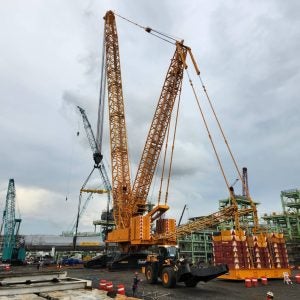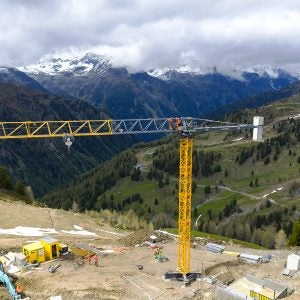The massive crane, which is the largest Potain crane to ever be used in North America, is working on the Generating Station and Spillways (GSS) Civil Works portion of Site C. When completed, the dam will be the province's fourth largest producer of electricity.
After some research on the market, Aecon-Flatiron-Dragados-EBC Partnership (AFDE), the construction group in charge of the project, acquired the Potain MD 3200 crane specifically for penstock installations on this job.
The crane arrived at the job site in February last year and started working in August, after being reconditioned to meet the group’s standards by EnCORE, Manitowoc Cranes, Tower Crane Division.
According to Nathan Johnson, deputy intakes and penstocks manager at AFDE, the company needed a crane with the ability to receive oversized loads, like large steel penstock sections—many of which weigh over 45.4t (50USt)—at one location and move them with ease into place.
The MD 3200 was erected on the Site C job site with its base attached to a custom rail track system that can move it along the length of the dam work site, nearly 107m (350ft). The crane has been affectionately named by some as “Sir Pix-a-Lot.”
Important features on the crane include its 101.1m maximum height, 85m jib, a capacity of 80t and a full extension lifting capacity of 26t. To complete lifts up and over the height and length of the dam from a given point, AFDE requested the crane to be designed and configured at 78m height, 70m jib, with 64t and a full extension capacity of 37t.
There are seven other Potain tower cranes working on site: two new MD 689 and five MD 560 cranes.
Construction on the Site C project commenced in 2015 and is expected to be completed in 2024. It will provide 1,100MW of capacity, and produce about 5,100 gigawatt hours (GWh) of electricity each year—enough energy to power the equivalent of about 450,000 homes per year in British Columbia.






